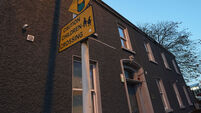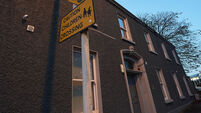Peat bog spits out Spitfire 70 years after crash
The operation at Moneydarragh, Co Donegal, was the latest chapter in the story of American pilot, Roland “Bud” Wolfe, who parachuted from the fighter plane into a diplomatic row between Britain and Ireland.
The 23-year old, a member of 133 Eagle Squadron, was on convoy when the engine overheated eight miles from his RAF base at Eglinton — now City of Derry Airport. Realising it would crash, he radioed back to base with a last message: “I’m going over the side.”
He then slid back the plane’s bubble canopy, released his safety harnesses and launched himself into the skies above a cold and foggy Inishowen peninsula on Sunday, November 30, 1941.
The single-seat plane soared down a steep, heather-covered valley before plunging deep into the peat.
The one-day dig was the first licensed excavation of a Second World War aircraft in Ireland and involved some of Britain’s top aviation archaeologists. It was organised by aviation historian, Jonny McNee, who began searching for the Spitfire six months ago, following numerous failed attempts by others. He said the plane was the first of 20 commissioned with £100,000 donated by Canadian millionaire, Willard Garfield Weston, during the Battle of Britain.
“This is the Holy Grail of Spitfires because of the tremendous history involved in it and the fact that it was the first Garfield Weston presentation plane. It has ‘Garfield Weston No 1’ written in four-inch yellow letters down the side of the cockpit,” said Mr McNee. He said the discovery was also prized because of the wreckage’s relatively good condition, the story of Wolfe’s two-year internment at the Curragh detention camp and the fact he survived the Second World War to fly in Korea and Vietnam. Wolfe died in Florida in 1994 at the age of 76.
While the plane was “pretty smashed up”, it was remarkably well preserved in the peat, according to British aviation archaeologist, Simon Parry. Mr Parry’s earlier research had found that the plane was involved in a gun battle with a German fighter plane seven months before it crashed in Co Donegal.
The operation began shortly after 8am with the plane’s muddied remains beginning to emerge at about six metres at 11am.
Among the salvage recovered by 4pm was parts of the fuselage, six Browning .303 machine guns, two magazines, hydraulic controls, 450 bullets, a propeller, tyres, landing gear and seat belts. A strong smell of aviation fuel clung to the air as the dig progressed.
An Army bomb disposal unit deactivated and made safe the machine guns and removed the munitions from the site.
Mick Harkin, 88, who witnessed the drama as he was leaving Mass as a 17-year-old, made his way through knee-deep heather yesterday to see the dig. “The plane was hovering about and we knew it was in trouble but we were miles away. I saw the pilot bail out and thought he was going to die but we heard later he landed safe. We were all very surprised. It was the talk of the time.”













